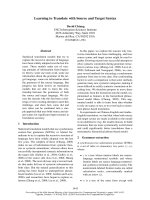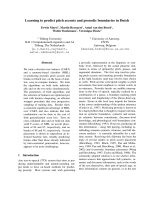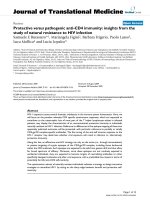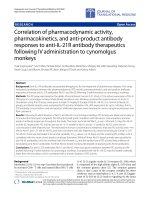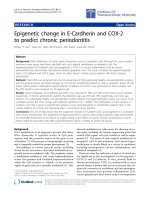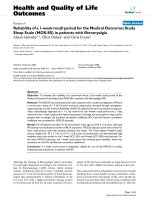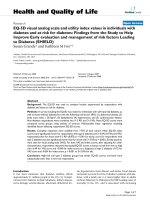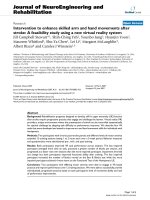Báo cáo hóa học: "SUPPLEMENTS TO KNOWN MONOTONICITY RESULTS AND INEQUALITIES FOR THE GAMMA AND INCOMPLETE GAMMA FUNCTIONS" pptx
Bạn đang xem bản rút gọn của tài liệu. Xem và tải ngay bản đầy đủ của tài liệu tại đây (478.42 KB, 8 trang )
SUPPLEMENTS TO KNOWN MONOTONICITY RESULTS
AND INEQUALITIES FOR THE GAMMA
AND INCOMPLETE GAMMA FUNCTIONS
A. LAFORGIA AND P. NATALINI
Received 29 June 2005; Accepted 3 July 2005
We denote by Γ(a)andΓ(a;z) the gamma and the incomplete gamma functions, respec-
tively. In this paper we prove some monotonicity results for the gamma function and
extend, to x>0, a lower bound established by Elbert and Laforgia (2000) for the function
x
0
e
−t
p
dt =[Γ(1/p) −Γ(1/p;x
p
)]/p,withp>1, only for 0 <x<(9(3p +1)/4(2p +1))
1/p
.
Copyright © 2006 A. Laforgia and P. Natalini. This is an open access article distributed
under the Creative Commons Attribution License, which permits unrestricted use, dis-
tribution, and reproduction in any medium, provided the original work is properly cited.
1. Introduction and background
In a paper of 1984, Kershaw and Laforgia [4] investigated, for real α and positive x,some
monotonicity properties of the function x
α
[Γ(1 + 1/x)]
x
where, as usual, Γ denotes the
gamma function defined by
Γ(a)
=
∞
0
e
−t
t
a−1
dt, a>0. (1.1)
In particular they proved that for x>0andα
= 0 the function [Γ(1 + 1/x)]
x
decreases
with x, while when α
=1 the function x[Γ(1 + 1/x)]
x
increases. Moreover they also showed
that the values α
= 0andα =1, in the properties mentioned above, cannot be improved if
x
∈ (0,+∞). In this paper we continue the investigation on the monotonicity properties
for the gamma function proving, in Section 2, the following theorem.
Theorem 1.1. The functions f (x)
= Γ(x +1/x), g(x) = [Γ(x +1/x)]
x
and h(x) = Γ
(x +
1/x) decrease for 0 <x<1, while increase for x>1.
In Section 3, we extend a result previously established by Elbert and Laforgia [2]re-
lated to a lower bound for the integral function
x
0
e
−t
p
dt with p>1. This function can be
expressed by the gamma function (1.1) and incomplete gamma function defined by
Γ(a;z)
=
∞
z
e
−t
t
a−1
dt, a>0, z>0. (1.2)
Hindawi Publishing Corporation
Journal of Inequalities and Applications
Volume 2006, Article ID 48727, Pages 1–8
DOI 10.1155/JIA/2006/48727
2 Supplements to the gamma and incomplete gamma functions
In fact we have
x
0
e
−t
p
dt =
Γ(1/p) −Γ
1/p;x
p
p
. (1.3)
If p
= 2 it reduces, by means of a multiplicative constant, to the well-known error func-
tion erf(x)
erf(x)
=
2
√
π
x
0
e
−t
2
dt (1.4)
or to the complementary error function erf c(x)
erf c(x)
=
2
√
π
∞
x
e
−t
2
dt =1 −
2
√
π
x
0
e
−t
2
dt. (1.5)
Many authors established inequalities for the function
x
0
e
−t
p
dt.
Gautschi [3] proved the following lower and upper bounds
1
2
x
p
+2
1/p
−x
<e
x
p
∞
x
e
−t
p
dt ≤a
p
x
2
+
1
a
p
−x
, (1.6)
where p>1, x
≥ 0and
a
p
=
Γ
1+
1
p
p/(p−1)
. (1.7)
Theintegralin(1.6) can be expressed in the following way
∞
x
e
−t
p
dt =
1
p
Γ
1
p
;x
p
=
1
p
Γ
1
p
−
x
0
e
−t
p
dt. (1.8)
Alzer [1] found the following inequalities
Γ
1+
1
p
1 −e
−x
p
1/p
<
x
0
e
−t
p
dt < Γ
1+
1
p
1 −e
−αx
p
1/p
, (1.9)
where p>1, x>0and
α
=
Γ
1+
1
p
−p
. (1.10)
Feng Qi and Sen-lin Guo [5] establisched, among others, the following lower bounds
for p>1
1
2
x
1+e
−x
p
≤
x
0
e
−t
p
dt, (1.11)
A. Laforgia and P. Natalini 3
if 0 <x<(1
−1/p)
1/p
, while
1
2
1 −
1
p
1/p
1+e
1/p−1
+
x −
1 −
1
p
1/p
e
−((x+(1−1/p)
1/p
)/2)
p
≤
x
0
e
−t
p
dt, (1.12)
if x>(1
−1/p)
1/p
.
Elbert and Laforgia established in [2] the following estimations for the functions
x
0
e
t
p
dt
and
x
0
e
−t
p
dt
1+
u
x
p
p +1
<
1
x
x
0
e
t
p
dt < 1+
u
x
p
p
,forx>0, p>1, (1.13)
1
−
v
x
p
p +1
<
1
x
x
0
e
−t
p
dt,for0<x<
9(3p +1)
4(2p +1)
1/p
, p>1, (1.14)
where
u(x)
=
x
0
e
t
−1
t
dt, v(x)
=
x
0
1 −e
−t
t
dt. (1.15)
In Section 3 we prove the following extension of the lower bound (1.14).
Theorem 1.2. For p>1, the inequality (1.14)holdsforx>0.
We conclude this paper, Section 4, showing some numerical results related to this last
theorem.
2. Proof of Theorem 1.1
Proof. It is easy to note that min
x>0
(x +1/x) = 2, consequently Γ
(x +1/x) > 0forevery
x>0. We have
f
(x) =
1 −
1
x
2
Γ
x +
1
x
. (2.1)
Since f
(x) < 0forx ∈ (0,1) and f
(x) > 0forx>1 it follows that f (x)decreasesfor
0 <x<1, while increases for x>1.
Now consider G(x)
= log[g(x)]. We have G(x) =xlog[Γ(x +1/x)]. Then
G
(x) = log
Γ
x +
1
x
+
x −
1
x
ψ
x +
1
x
,
G
(x) = 2ψ
x +
1
x
+
x −
1
x
1 −
1
x
2
ψ
x +
1
x
.
(2.2)
Since G
(1) =0andG
(x) > 0forx>0itfollowsthatG
(x) < 0forx ∈ (0,1) and G
(x) >
0forx
∈ (1,+∞). Therefore G(x), and consequently g(x), decrease for 0 <x<1, while
increase for x>1.
Finally
h
(x) =
1 −
1
x
2
Γ
x +
1
x
. (2.3)
4 Supplements to the gamma and incomplete gamma functions
Since Γ
(x +1/x) > 0, hence h
(x) < 0forx ∈(0, 1) and h
(x) > 0forx>1. It follows that
h(x)decreaseson0<x<1, while increases for x>1.
3. Proof of Theorem 1.2
By means the series expansion of the exponential function e
−t
p
,wehave
x
0
e
−t
p
dt =
∞
n=0
(−1)
n
x
np+1
(np+1)n!
,
v
x
p
=
∞
n=1
(−1)
n−1
x
np
nn!
,
(3.1)
consequently the inequality (1.14) is equivalent to the following
1
−
1
p +1
∞
n=1
(−1)
n−1
x
np
nn!
<
1
x
∞
n=0
(−1)
n
x
np+1
(np+1)n!
, (3.2)
that is,
1
−
x
p
p +1
+
x
2p
(p+1)2·2!
−
x
3p
(p +1)3·3!
+
···< 1 −
x
p
p +1
+
x
2p
(2p +1)2!
−
x
3p
(3p +1)3!
+
···.
(3.3)
Since for every integer n
1
(np+1)n!
−
1
n(p +1)n!
=−
n −1
(p +1)n ·n!(np+1)
, (3.4)
by putting z
= x
p
the inequality (1.14)isequivalentto
s(z)
=
1
p +1
∞
n=2
(−1)
n
n −1
(np+1)n ·n!
z
n
> 0; (3.5)
it is clear that the series to the rig ht-hand side of (3.5)isconvergentforanyz
∈ R.We
can observe that, for p>1,
(p +1)s
3
(z) =
3
n=2
(−1)
n
n −1
(np+1)n ·n!
z
n
= z
2
1
4(2p +1)
−
z
9(3p +1)
> 0 (3.6)
when 0 <z<9(3p +1)/4(2p +1). As a consequence of a well known property of Leibniz
type series we have 0 <s
3
(z) <s(z)for0<z<9(3p +1)/4(2p + 1) just like was proved by
Elbert and Laforgia in [2].
It is easy to observe that z
= 0 represents a relative minimum point for the function
s(z)definedin(3.5). In fact we have s(z) > 0forz<0and0<z<9(3p +1)/4(2p +1).
Now we can prove Theorem 1.2 by using the following lemma.
Lemma 3.1. The function s(z),definedin(3.5), have not a ny relative maximum point in
the interval (0,+
∞).
A. Laforgia and P. Natalini 5
Proof. For any n
≥ 1 consider the partial sum of series (3.5)
(p +1)s
2n
(z) =
2n
k=2
(−1)
k
k −1
(kp+1)k ·k!
z
k
(3.7)
and multiply this expression by pz
1/p
;wehave
pz
1/p
(p +1)s
2n
(z) =
2n
k=2
(−1)
k
k −1
k ·k!((kp+1)/p)
z
(kp+1)/p
. (3.8)
Deriving and dividing by z
1/p−1
we obtain
(p +1)
s
2n
(z)+pzs
2n
(z)
=
2n
k=2
(−1)
k
k −1
k ·k!
z
k
. (3.9)
A new derivation give us the following expression
(p +1)
(p +1)s
2n
(z)+pzs
2n
(z)
=
2n
k=2
(−1)
k
k −1
k!
z
k−1
. (3.10)
Dividing by z and re-writing, in equivalent way, the indexes into the sum to the right-
hand side, the last expression yields
(p +1)
(p +1)
s
2n
(z)
z
+ ps
2n
(z)
=
2n−2
k=0
(−1)
k
k +1
(k +2)!
z
k
. (3.11)
Now consider the following series
∞
k=0
(−1)
k
k +1
(k +2)!
z
k
; (3.12)
we have for every z
∈ R
∞
k=0
(−1)
k
k +1
(k +2)!
z
k
=
∞
k=0
(−1)
k
z
k
(k +1)!
−
∞
k=0
(−1)
k
z
k
(k +2)!
=
1 −
z
2
+
z
2
3!
−
z
3
4!
+
···
−
1
2
−
z
3!
+
z
2
4!
−
z
3
5!
+
···
=
1
z
z −
z
2
2
+
z
3
3!
−
z
4
4!
+
···
−
1
z
2
z
2
2
−
z
3
3!
+
z
4
4!
−
z
5
5!
+
···
=
1 −e
−z
z
−
e
−z
−1+z
z
2
=
f (z)
z
2
,
(3.13)
where f (z)
= 1 −(z +1)e
−z
.
6 Supplements to the gamma and incomplete gamma functions
Since f (0)
= 0and f
(z) = ze
−z
> 0forz>0, it follows that f (z) > 0 ∀z ∈ (0,+∞).
From (3.11), by n
→ +∞,weobtain
(p +1)
(p +1)
s
(z)
z
+ ps
(z)
=
f (z)
z
2
, (3.14)
for every z
∈ R. If we assume that
¯
z>0 is a relative maximum point of s(z)thens
(
¯
z) = 0
and s
(
¯
z) < 0, but this produces an ev ident contradiction when we substitute z =
¯
z in
(3.14).
Proof of Theorem 1.2. Since s(z) > 0 ∀z ∈ (0,9(3p +1)/4(2p + 1)), if we assume the exis-
tence of a point
¯
z>9(3p +1)/4(2p +1)suchthats(
¯
z) < 0 then there exists at least a point
ζ
∈ (9(3p +1)/4(2p +1),
¯
z)suchthats(ζ) = 0. Let ζ, eventually, be the smallest positive
zero of s(z), hence we have s(0)
= s(ζ) = 0ands(z) > 0 ∀z ∈ (0,ζ). It follows therefore,
that there exists a relative maximum point z
0
∈ (0,ζ) for the function s(z), but this is in
contradiction whit Lemma 3.1.
4. Concluding remark on Theorem 1.2
In this concluding section we repor t some numerical results, obtained by means the com-
puter algebra system Mathematica ©, which justify the importance of the result obtained
by means of Theorem 1.2.Webrieflyput
I(x)
=
x
0
e
−t
p
dt, (4.1)
while denote with
A(x)
= Γ
1+
1
p
1 −e
−x
p
1/p
(4.2)
the lower bound established by Alzer [1], with
G(x)
=
1
p
Γ
1
p
−
e
−x
p
a
p
x
2
+
1
a
p
−x
(4.3)
that one established by Gautschi [3], with
Q(x)
=
1
2
1 −
1
p
1/p
(1 + e
1/p−1
)+
x −
1 −
1
p
1/p
e
−((x+(1−1/p)
1/p
)/2)
p
(4.4)
that one established by Qi-Guo [5]whenx>(1
−1/p)
1/p
, and finally with
E(x)
= 1 −
v
x
p
p +1
(4.5)
that one established by Elbert-Laforgia [2].
A. Laforgia and P. Natalini 7
Therefore the following numerical results are obtained:
(i) for p
= 50 and x =1.026 > (9(3p +1)/4(2p +1))
1/p
= 1.023456, we have
I(x)
−E(x) =0.000272222,
I(x)
−A(x) =0.000417332,
I(x)
−G(x) =−0.0108717,
I(x)
−Q(x) =0.301341;
(4.6)
(ii) for p
= 100 and x =1.013 > (9(3p +1)/4(2p +1))
1/p
= 1.01222,
I(x)
−E(x) =0.0000690398,
I(x)
−A(x) =0.000205222,
I(x)
−G(x) =−0.0107205,
I(x)
−Q(x) =0.308547;
(4.7)
(iii) for p
= 200 and x =1.0065 > (9(3p +1)/4(2p +1))
1/p
= 1.0061,
I(x)
−E(x) =0.0000173853,
I(x)
−A(x) =0.000101731,
I(x)
−G(x) =−0.106414,
I(x)
−Q(x) =0.312265.
(4.8)
In these three numerical examples we can note that there exist values of x>(9(3p +
1)/4(2p +1))
1/p
such that E(x) represents the best lower bound of I(x)withrespectto
A(x), Q(x), and G(x). Moreover we state that this is always true in general, more pre-
ciously we state the following conjecture: for any p>1, there exists a right neighbour-
hood of (9(3p +1)/4(2p +1))
1/p
such that E(x) represents the best lower bound of I(x)
with respect to A(x), Q(x), and G(x).
References
[1] H. Alzer, On some inequalities for the incomplete gamma function, Mathematics of Computation
66 (1997), no. 218, 771–778.
[2]
´
A. Elbert and A. Laforgia, An inequality for the product of two integrals relating to the incomplete
gamma function, Journal of Inequalities and Applications 5 (2000), no. 1, 39–51.
[3] W. Gautschi, Some elementary inequalities relating to the gamma and incomplete gamma function,
Journal of Mathematics and Physics 38 (1959), 77–81.
[4] D. Kershaw and A. Laforgia, Monotonicity results for the gamma function,AttidellaAccademia
delle Scienze di Torino. Classe di Scienze Fisiche, Matematiche e Naturali 119 (1985), no. 3-4,
127–133 (1986).
8 Supplements to the gamma and incomplete gamma functions
[5] F. Qi and S L. Guo, Inequalities for the incomple te gamma and related functions, Mathematical
Inequalities & Applications 2 (1999), no. 1, 47–53.
A. Laforgia: Department of Mathematics, Roma Tre University, Largo San Leonardo Murialdo 1,
00146 Rome, Italy
E-mail address:
P. Natalini: Department of Mathematics, Roma Tre University, Largo San Leonardo Murialdo 1,
00146 Rome, Italy
E-mail address:
